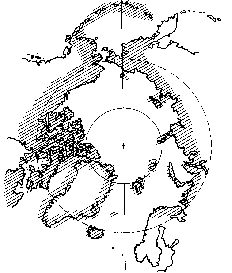English Name:
-Ice-Fox
-2 color Mutants, one called Blue fox / Polish blue, the other
white fox
other Names
German:
-Eisfuchs (Blaufuchs, Arktischer Fuchs, Steinfuchs)
-2 color Mutants called Blaufuchs and Wei▀fuchs
Russian:
-[Pesetz] (sorry, I know how to write russian, but I do'nt've a
russian font so I'd to write the spelling.)
-Krestovatiki, Nedopesiki
France:
-Renard arctique
Group
-
Lathin Name:
-Alopex lagopus
-Alopex lagopus lagopus
appearance:
-length without tail: 46,5 - 73 cm
-tail-length: 25 - 52 cm
-weight: 2 - 8m8 Kg (haviest in december)'
-lagopus is the only fox which ear-tips are rounded
-Whelps: weight at birth: 60-85 g and a body length (excluding
the tail) of 11-13 cm (tail only: 4,2-6,0 cm)
-winterpelt: white(White Fox, a cream-colored shade is possible)
or blue(Blue Fox, from sand-yellow, gray, bright coffee-brown to
a dark ash-gray with a blue shade, bright- or dark
cinnamon-colored with a glimmer of silver because of white
leading-hair-tips, same color on whole body)
-summerpelt: neck and back smoke-gray with fox-reddish tones
flanks a brighter peritoneum(belyfur) more white legs and brines
brownish gray tail on top brownish buttom in pale redfoxlike
shades head brownish gray like ear-outsides ear-insides white
-dark stripes across back and shoulders in summer if it's a
cross-fox (no cross-foxes from Blue Foxes)
-cubs are cross-foxes when leaving the den
-whinterfur double lenght of summerfur (45.8 mm leading-hair,
37.9 mm wool) also thicker
-wool estimates 97% of haires (very fluffy and warm)
Geographic Range:
-Palearctic, Nearctic: treeless tundra extending through the
arctic regions of Eurasia, North America, Greenland, and Iceland.
-Summer: treeless tundra of: Eurasia, Greenland, North America
and polar, arctic isles (including Iceland and the Aleuts)
-Winter: from tree-tundra at south to icefields of the Polar-see
-(2/3 of the population are traveling when the winter comes)

Habitat:
-mainly in arctic and alpine tundra, usually in coastal areas. arctic isles, on free Ice
Behaviour:
Activity: Day,- twilightactive.
- communal and nomadic life, often small bands to scavenge the
countryside for food. do not hibernate construct homes called
dens,often in cliffs at least 1.6 km apart family social group
This group consists of 1 adult male,the litter and two vixens--1
of the vixens a (nonbreeding) animal born the prev. year that
stays to help care for the next litter. generally makes its den
in a low mound 1-4 meters high in the open tundra, or in a pile
of rocks at the base of a cliff. 4-8 entrances and a system of
tunnels covering about 30 m^2. Some have been used for centuries
by generations of foxes.
-monogamous, usually mate for life.(eyceptionionally polygam or
polyandrit)
-The male parent stays with the cubs, helping to feed them. He
mates a few weeks after the first litter is born.
-traveling up to 2000 Km to reach their
"summer-habitat", following the polar-bears
-a "few" non-traveling animals existing too
-if they killed a goose they are cariing it on theirself
-every 4-6 years there are mass-travelings (f.a. on Nawaja
Semlja) where hundrets of ice-foxes are traveling together
-OFTEN barking or growling
Reproduction
-mating mainly: March.-Jul. (Feb.-May.) (longer if less food
availiable)
-births Apr.-Jun. for the first litter,(Apr.-Jun.) and Jul./Aug.
for the second litter.
-average gestation period 49-57days. normal: 52 (51-52)
-number of young per litter varies with availability of
food(esp.lemmings) usual litter size: 5-12 (max known 25)(1-22
ě3-5)
*if less food is aviable they may die inside the mothers body for
that the mother survive and the others have a chance for being
born (only 3-5)
*after 1 or two years with a big litter size the litter of this
vixen shrinks rapidly or there may be no birth. (causes
"problems" in fur-farms)
-weaned at about 2-4 weeks (up to 2,5 month, but eat nearly only
solid food after 1,5 month)
-first time seen outside: 3-4 weeks( June/July)
-emerge from the den.(8-10) (august-october, varies with
availiability of food)(dog foxes a bit earlier)
-reach sexual maturity in <10 months (1-2 years)
-life span 6-10 years (in human care up to 20 years)
Food Habits:
-after the 9.-18.day the cubs are able to eat solid food (as
soon as they open their eyes)
-eating practically any animal, alive or dead. prefers small
mammals insects, berries, carrion, stool of animals or human
beings.
-winter(>Dec): marine mammals, invertebrates, sea birds, fish,
and seals. more inland and in the
-changes the fur in Feb-Jun(losing winter-fur) Apr-Aug(getting
new summer-fur) and Aug-Sep(loosing summer-fur) Oct-Dec(getting
winter-fur)
-Ice-foxes in Greenland are allways white (short summer)
-summer: lemmings During the summer months:
-mainly: geese
-125 different animals and 25 plants proved
-collects food and carries it to its dens, where it is stored
under stones for later use.
Specialities :
-more sociable, exspecially at foodabundant places. only timewise or in Foodabundant Areas ortstreu.
others :
-Fur has the highest quality in Dec-Feb (very long and dense)
-fur-quaity is influenced by low temperatures and a high humidity
during the moult in October and good food in fall but not in
summer
-Blue fox has the most expensive pelt
-blue color is dominant
-In summer there may be cross-foxes apearing >>see Vulpes vulpes
Links
(dead link reoved)
(dead link reoved)
(dead link reoved)
(dead link reoved)